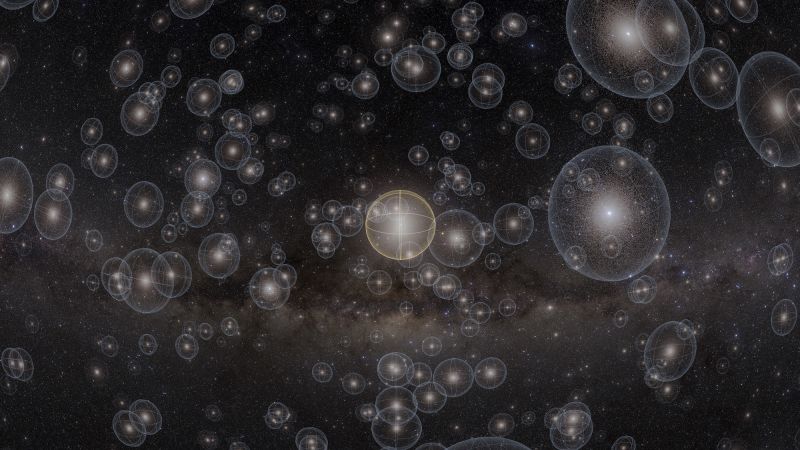**Exploring the Oort Cloud: A New Perspective on Our Solar System**
An accidental discovery has the potential to significantly alter our understanding of one of the most enigmatic features of our solar system: the Oort Cloud. This vast region is believed to house innumerable icy bodies orbiting the Sun at a distance approximately 1,000 times farther than Neptune’s orbit, forming what scientists presume to be a spherical shape, despite it never having been directly observed.
The unexpected revelation came during the preparatory work for a new planetarium show titled “Encounters in the Milky Way,” which premiered at the Hayden Planetarium in New York City. While testing visual projections of Earth’s surroundings—from the Sun to the far reaches of our solar system—a team stumbled upon a surprising feature within the Oort Cloud: a spiral structure reminiscent of a spiral galaxy, akin to our Milky Way. Jackie Faherty, an astrophysicist at the American Museum of Natural History and curator of the exhibit, recounted her astonishment upon first witnessing the imagery. “We hit play on the scene, and immediately we saw it. It was just there… I was confused and thought that was super weird. I didn’t know if it was an artifact, I didn’t know if it was real,” she shared.
Upon raising her concerns about this discovery, Faherty reached out to David Nesvorny, a distinguished scientist at the Southwest Research Institute in Boulder, Colorado, and a leading expert on the Oort Cloud. It turned out that the simulation responsible for the visual element had been developed by Nesvorny and was firmly grounded in prevailing physics. “We didn’t create it — David did,” Faherty confirmed.
Interestingly, Nesvorny initially regarded the spiral as a mere artifact of the data visualization. However, upon analyzing his data more closely, he validated the spiral’s existence and went on to publish a groundbreaking paper in The Astrophysical Journal in April, detailing this discovery. Reflecting on this unique pathway to discovery, he acknowledged, “Weird way to discover things… I should know my data better, after years of working with it.”
The Oort Cloud was a theoretical concept introduced by Dutch astronomer Jan Oort in 1950. He envisioned it as a spherical shell of icy objects persisting around the solar system, possibly extending as far as 1.5 light-years from the Sun. This region represents the outer limits of our solar system, encompassing materials leftover from the formation of planetary bodies—scattered haphazardly after the planets took shape.
The Oort Cloud’s complexity lies in its diverse orbital characteristics. Many of its icy constituents do not follow a co-planar orbit with the solar system, traveling at various tilt angles. Comets emerge from the Oort Cloud when one of these icy bodies is propelled toward the Sun, where solar heating causes materials to vaporize, forming a tail and characterizing comets.
Faherty pointed out that every so often, some of these icy bodies venture into the inner solar system, revealing highly elongated orbits. These journeys provide insight into their origins, potentially tracing their trajectories to the distant Oort Cloud.
Despite being enveloped by the Oort Cloud, scientists have never successfully observed it directly due to the small size and great distance of its components—many measuring less than 60 miles (97 kilometers) across and potentially numbering in the trillions.
Nesvorny’s spiral formation was obscured in his initial analyses because he had not contemplated visualizing it in three-dimensional Cartesian coordinates. “I never looked at it in Cartesian coordinates — I didn’t have a good reason to do so. But once you do that, it’s obvious. It’s there,” he explained.
To substantiate his findings, Nesvorny employed NASA’s Pleiades Supercomputer, one of the world’s most powerful computational resources, to execute complex simulations taking several weeks to finalize. He was concerned that the unique simulation leading to the spiral could represent something isolated. However, further models reaffirmed the spiral’s presence across various conditions, illustrating that the observed phenomenon was consistent.
This spiral’s formation is attributed to cosmic influences; objects in the Oort Cloud are positioned far beyond the Sun’s gravitational influence, thus being susceptible to the galactic tide—the gravitational field imposed by our galaxy’s dark matter and stars. As a result, the orbits of these small bodies become twisted, producing the spiral structure observed.
According to Nesvorny, the spiral is located within the inner region of the Oort Cloud, closer to our solar system, while he continues to assert that the outer regions maintain a spherical shape. Observing the Oort Cloud is inherently challenging, although the recently launched Vera C. Rubin Observatory in Chile is poised to enhance our understanding by identifying icy bodies within it. Nevertheless, it remains unlikely that the observatory will unveil enough objects to render a comprehensive visualization of the spiral.
From a theoretical



